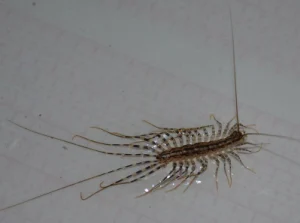Млада жена стана милионерка, 28-годишна жителка на Македонија
Bitcoin Bank
What feeling do you have when you discover an insect around your house? You probably simply want to reach for anything and stomp on them immediately, and for good reasons too. Some of them carry horrible chemicals and can sting you painfully and even fatally.
The creepies are the ones that make you feel the worst; those small, scary critters with so many legs usually make you want to squeeze the life out of them right away.
However, after reading this, you might be hesitant to kill those horrifying-looking centipedes the next time you see them lurking in your toilet.

When you see centipedes moving around the house, it can be quite difficult to resist the urge to squash them. Centipedes can cause you quite the shock. But after hearing how helpful they have been around the house, you might want to just thank them by avoiding killing them going forward.
As it turns out, those squirmy, swiftly moving organisms have been protecting your house from other tiny insects.
Around the home, there is an unique kind of centipede that is a little bit shorter than its other wormy cousins and has around 20 legs wrapped around their body.
Those little creatures have served as your home’s invisible pest control, keeping cockroaches, spiders, silverfish, bedbugs, and ants out of your home. They almost devour every arthropod they discover around the house because of their ravenous appetite.
Although centipedes are the good guys, this doesn’t mean you should just throw up your doors and let them enter in massive numbers; instead, it only means you should let the one or two you may discover around the house off the hook the next time they visit as a gesture of gratitude.
When they are discovered, they could make a little noise, especially if young children or even adults find them repulsive and filthy. But rather of simply squashing them, let them go on their own or send them outside to eat some leaves.
Avoid squashing spiders and risking the danger of releasing hundreds of tiny baby spiders into your home by refraining from squashing every bug you encounter inside. You don’t really want to witness it.
Additionally, centipedes are actually not that nasty. They are merely frail tiny critters that can barely be powerful enough to do significant harm, other from frightening your heart.
It will also persuade you that they are truly the nice guys if you take into account the fact that they don’t actually transmit germs around the house as other insects do.
Even the centipedes shouldn’t scare you; they are essentially non-lethal. We can’t truly say the same about a couple others, though. Numerous dreadful illnesses that are extremely harmful and might result in death without proper medical care are brought on by these insects.
You should really be on the lookout for those. Here are a handful of the deadly insects that you should hope never to encounter indoors.
As their name suggests, bullet ants make you feel like you’ve been shot after being bitten. Thus, you should make an effort to prevent getting bitten. They are one of the biggest ant species and are frequently seen in the Paraguayan and Nicaraguan jungles.
The larvae of the botfly, an inside parasite of many animals, including humans, are the issue, not the actual botfly itself. The female lays her eggs under the skin, and as the larvae develop, they burrow further into the skin, creating an infection that causes significant changes in the skin’s tissue.
Some parents claim to be able to feel the larvae crawling inside of their skin.
Fleas: Since they are blood-feeders, flea bites can itch, irritate, and occasionally even infect the skin.
Fire ants: These infamous stingers can repeatedly sting an invader, causing painful white pustules that may last for weeks on the skin. Ants come in more than 295 distinct species. Certain of them release poisonous venom that might make some people react allergically.

The trypanosome cruzi parasite, which the kissing bug is known for transmitting by biting its victims’ lips, may be the cause of up to 12,000 fatalities each year.
Giant Japanese Hornets are the biggest hornets, growing up to 2 inches long and packing a lethal sting that claims the lives of roughly 40 people annually.
Tsetse Flies: Sleeping sickness brought on by tsetse flies’ bites is thought to be the cause of 500,000 fatalities on the African continent.
Killer Bees: Because of their sheer numbers, killer bees frequently attack violently and in overwhelming numbers, which often proves lethal.
Driver ants: These ants attack with great force thanks to their strong mandibles. In a single raid, they may dispatch a number of animals. They attack other insects as well, and they have a nasty tendency to bite people.
Mosquitoes: Known as the deadliest insects and maybe the deadliest organisms on earth, mosquitoes are thought to be the cause of up to 1 million fatalities annually due to illnesses including encephalitis, West Nile virus, malaria, and yellow fever.





